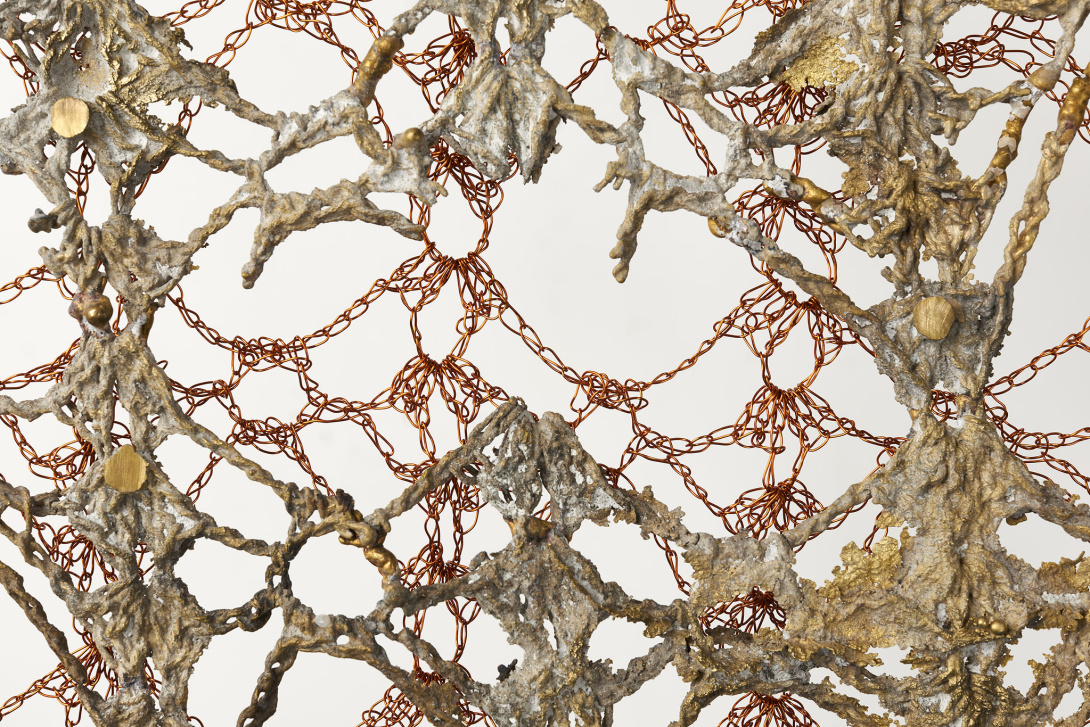Updated September 8, 2025: From October 17, 2025 through June 7, 2026, the San José Museum of Art (SJMA) will present ektor garcia: loose ends, the first solo museum exhibition in California by Mexico City–based artist ektor garcia. This exhibition marks a homecoming for garcia, who was born in California and spent his formative years in the Bay Area. It brings together existing and newly created sculptures in a single installation that reflects garcia’s ongoing exploration of transformation, labor, and identity through material and process.
garcia’s work is shaped by a rich and eclectic array of influences, from Mexican handcraft traditions passed down by his grandmother to a DIY sensibility shaped by his Bay Area upbringing. His practice also incorporates techniques learned through YouTube tutorials and global travel. He often weaves in symbols from Mexican folktales and colloquialisms, queer subcultures, and transitional architectural forms like portals, windows, and curtains. Through this layered approach, garcia challenges social and cultural hierarchies, particularly those tied to gendered and racialized labor, while rejecting fixed definitions of existence or identity.
His material vocabulary is unconventional. It includes copper wire, cast metals, glass, clay, horsehair, seashells, leather, onyx, volcanic rock, and in one instance, even a dried pig’s ear, which are crocheted, knotted, woven, or cast into works that are simultaneously vulnerable and resistant, soft and hard, pliable and immobile.
“garcia’s work is always evolving. His sculptures seem quiet but restless, psychologically and politically charged in their deceptive delicacy and susceptibility to change,” said Lauren Schell Dickens, SJMA’s chief curator. “At the San José Museum of Art, we look to support artists who push boundaries and reflect the complexities of our time. garcia’s practice embodies that spirit. This exhibition is a snapshot of a larger, ongoing journey and one that speaks to transformation, resistance, and possibility.”
Each piece often begins with a single stitch or gesture, gradually growing into large-scale chains, fabrics, wreaths, or altar-like accumulations. He frequently dismantles earlier works, dissecting and repurposing elements for new iterations. garcia’s work opens up possibilities for making and knowing that are constantly engaged in a deliberate process of unraveling and reworking, learning, and quiet change.
In homage to the feminist thinker bell hooks, garcia stylizes his name in lowercase letters as a gesture toward fluidity and the rejection of fixed subjectivity. His sculptures reflect this ethos: diaristic, open-ended, and perpetually in flux.
As part of SJMA’s partnership with Bloomberg Philanthropies, the exhibition will also feature new and original multimedia content hosted on the free Bloomberg Connects app. The arts and culture app will host a digital guide of the exhibition, which will include an interview with the artist and commentary relating to the new installation.
ektor garcia
ektor garcia (b. 1985, Red Bluff, California, based in Mexico and elsewhere) received his BFA from the School of the Art Institute of Chicago in 2014, and his MFA from Columbia University in 2016. He has had solo exhibitions at the Henry Art Gallery, University of Washington at Seattle (2022), the Sculpture Center, New York (2019), and the Museum Folkwang, Essen Germany. His work has been featured in group exhibitions at the Whitney Biennial 2024: Even Better than the Real Thing at the Whitney Museum of Art, New York (2024); Blaffer Art Museum, Houston, Texas (2024); the Cantor Arts Center at Stanford University, Palo Alto (2024); Berkeley Art Museum & Pacific Film Archive (2024); San Francisco Museum of Modern Art (2022); the Griffith University Art Museum, Brisbane, Australian (2022); Yesterday We Said Tomorrow, Prospect 5 New Orleans (2021); Estamos Bien: La Trienal 20/21, El Museo del Barrio, New York (2021), Museo Tamayo, Mexico City, Mexico (2021); Hangzhou Triennial of Fiber Art, Hangzhou, China (2019); and many others.
Support
ektor garcia: loose ends is made possible by the SJMA Exhibitions Fund, with major support from Brook Hartzell and Tad Freese. Additional support provided by Rebecca Camacho Presents.
Operations and programs at the San José Museum of Art are made possible by principal support from SJMA’s Board of Trustees, and a Cultural Affairs Grant from the City of San José; by lead support from the Adobe Foundation, the William Randolph Hearst Foundation, Tammy and Tom Kiely, Yvonne and Mike Nevens, the David and Lucile Packard Foundation, the Skyline Foundation, the Teiger Foundation, the Andy Warhol Foundation for the Visual Arts, and the SJMA Director's Council and Council of 100; and with significant endowment support from the William Randolph Hearst Foundation and the San José Museum of Art Endowment Fund established by the Knight Foundation at the Silicon Valley Community Foundation.
SAN JOSE MUSEUM OF ART
The San José Museum of Art (SJMA) is a modern and contemporary art museum dedicated to inclusivity, new thinking, and visionary ideas. Founded in 1969 by artists and community leaders, its dynamic exhibitions, collection, and programs resonate with defining characteristics of San José and the Silicon Valley—from its rich diversity to its hallmark innovative ethos. The Museum offers lifelong learning for school children and their educators, multigenerational families, creative adults, university students and faculty, and community groups. SJMA is committed to being a borderless museum, essential to creative life throughout the diverse communities of San José and beyond.
SJMA is located on Plaza de Cesar Chavez at 110 South Market Street in downtown San José, California. The Museum is open Thursday 4–9pm; Friday 11am–9pm; Saturday–Sunday 11am–6pm. Admission is $20 for adults, $15 for seniors, and free to members, college students, youth and children ages 17 and under, and school teachers (with valid ID). Admission is free from 6–9pm on the first Friday of every month. For up-to-date information, call 408.271.6840 or visit SanJoseMuseumofArt.org.
